Team USA 2000 SoCal Qualifying Runs
Results and Photos by Joe Moell KØOV
Two Meters, June 3, 2000
Bright sun, 90-degree temperatures and difficult hiding locations made for a world-class physical and mental challenge on Saturday. LAOC's excellent orienteering map included the landscaped grounds of Schabarum Regional Park plus the rugged hills of the Powder Canyon Wilderness. There were alternating areas of thickets and tall dry grass, with a few small forested areas for good measure.
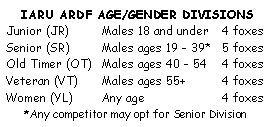 The weekend's hunts were official qualifying events for the USA's ARDF Team, which competed at the 2000 World Championships in Nanjing, China during the second week of October. Six team members were in attendance, two from the local area and the remainder traveling from Cincinnati, Santa Barbara, and the San Francisco Bay.
The weekend's hunts were official qualifying events for the USA's ARDF Team, which competed at the 2000 World Championships in Nanjing, China during the second week of October. Six team members were in attendance, two from the local area and the remainder traveling from Cincinnati, Santa Barbara, and the San Francisco Bay.
In addition to a five-fox course for five age/gender divisions as called out in International Amateur Radio Union (IARU) rules (in effect during 2000, see box at left), there was a Novice (beginner) level course made up of two of the advanced foxes plus three others.
The five-transmitter advanced course was fully compliant with IARU rules for course length, transmitter separation and timing. All foxboxes were plainly marked with an ARDF version of the orienteering control symbol. None were buried or concealed inside a covered object. Punches were readily visible to sharp-eyed observers, either at ground level or eye level.
All foxes ran the same power level (0.9 watts) into identical antennas. Voltage regulators kept the RF output power constant through the hunt, compensating for battery voltage sag. The only departures from current Euro/Asian-based IARU transmitter requirements were the use of FM instead of AM tones and vertical instead of horizontal polarization. This made it easier for hams using ordinary handi-talkies and/or RDF sets with dual switched vertical whips.
ARDF championship courses are 5 to 10 kilometers. Course lengths (point-to-point in kilometers) for this hunt are in the division headings below. Of course it was not possible to run point-to-point, especially in the wilderness. Advanced course transmitters (MOE, MOI and MOS) were accessible from trails, but they were near hilltops in the wilderness. Steep hills, cliffs and thickets made direct travel impossible in many places, so practical course lengths for the advanced courses were 9 to 10 Km.
Multipath (VHF signal reflections) made the advanced courses much more difficult than anticipated. For instance, MOS was in a small forest near a footpath. The canyons and other terrain features bounced and funneled the signal to the northeast where it "lit up" a major power line tower. Several ARDFers followed the signal up the trail to this tower and became convinced that they were very close to MOS, even though it was a half-kilometer away through the thicket and 300' higher. At the end, nobody had punched in at MOE, MOI or MOS, despite their brave attempts.
The list below shows elevation of each T (in feet above sea level), distance from nearest trail (in feet) and number of hunters that found it. Also listed are the age/gender divisions that were required to find each one. The starting point elevation was 620 feet.
I.D. DIVISIONS ELEV DIST #
MOE JR, SR, OT, VT, YL 970' 130' 0
MOI JR, SR, OT, YL 840' 8' 0
MOS SR, OT, VT, YL 1010' 40' 0
MOH JR, SR, OT, VT 500' 15' 7
MO5 JR, SR, VT, YL 470' 60' 5
MO6 Novice 480' 30' 0
MO Novice 670' 60' 2
Tones Novice 590' 25' 2
MO served both as a Novice course fox and as a finish line transmitter for the advanced courses.
Fourteen persons were timed from the starting point. Three didn't find any transmitters. Here are results for the others (name/callsign, number of foxes, and elapsed time):
Novice (3.0 Km)
Megan Dods KG6AAS 4 2:12:27
Buddy Dods + 2 friends 2 1:59:50
Dean Dods KD6I 2 2:07:00
Scott Dickson 2 2:45:00
Matthew Cook (lost card)
Junior (5.8 Km)
Jay Thompson W6JAY 2 1:28:22
Old Timer (6.5 Km)
Richard Thompson WA6NOL 1 0:58:15
Marvin Johnston KE6HTS 1 1:44:23
Veteran (6.0 Km)
Bob Cooley KF6VSE 2 4:32:00
All of the 2m hunters were so consumed (and fatigued?) with finding 2-meter foxes that none of them looked for the 80-meter bonus fox on Saturday. The only one to find it was Christie Edinger K0IU, who arrived in mid-afternoon (after running a marathon in Palos Verdes that morning) and did the 1.5 Km trip to it and back in a quick sprint.
A big thank-you to the Hospital Disaster Support Communications System (HDSCS) medical team (Jon Schaffer W6UFS and Jackie Schaffer WA6AKP) for providing water and first aid resources for this hunt. It's good that they were present, as one hunter had to be helped back from Schabarum Trail and treated for exhaustion and dehydration. Some others returned with cuts and scratches from the thickets.
Eighty Meters, June 4, 2000
Team USA members made up for Saturday's two-meter troubles when they went 80m hunting on Sunday in William R. Mason Regional Park. This was the first-ever IARU-rules foxhunt on the 80m band to be held in California.
Being much closer to the ocean, this 215-acre site in Irvine was cooler with a light breeze. It includes both a landscaped urban picnic/play zone and a "skinny" riparian corridor with a creek (convenient for submerging long transmitting antenna radials) and paved jogging trails. Cross-country running was possible in most places; the main danger was the need to cross two busy streets to get from one end to the other. (Though warned by the county's signs, nobody encountered any mountain lions.)
Point-to-point course lengths were 6.3 Km for all divisions. Because of the park layout, minimum practical course lengths were about 7 Km. Direction finding is much simpler on 80m due to lack of signal reflections, so an ability to take bearings and move quickly was the key to success in this event.
Although qualified by age for the 4-fox Veteran Division, Bob Cooley chose to run in the 5-fox Senior Division, as is permitted by international rules. Here are the results:
Junior (JR)
Jay Thompson W6JAY 4 2:12:34
Senior (SR)
Bob Cooley KF6VSE 5 1:35:55
Old Timer (OT)
Bob Frey WA6EZV 4 1:24:02
Dick Arnett WB4SUV 4 1:24:15
Marvin Johnston KE6HTS 4 1:25:25
Richard Thompson WA6NOL 1 0:28:57
Notice the closeness of scores in Old Timer division! Do we have a well-matched team?
Thanks to everyone who participated. Special thanks to April WA6OPS who handled start/finish timing, prizes, and snacks.
Photos
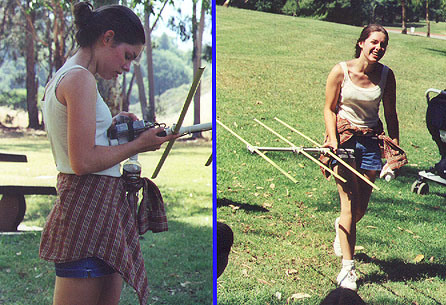
Megan Dods KG6AAS found more fox transmitters than anyone else on Saturday. Here she is before (getting her first bearing) and after (crossing the finish line).

An "after two meters" shot of the six Team USA candidates. Left to right they are Dick Arnett WB4SUV, Jay Thompson W6JAY, Richard Thompson WA6NOL, Bob Frey WA6EZV, Marvin Johnston KE6HTS and Bob Cooley KF6VSE.
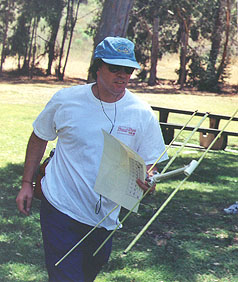
You don't have to have a ham radio license to enjoy ARDF, as Scott Dickson demonstrates.

Jackie Schaffer WA6AKP of HDSCS disinfects Trevor Wood's "two meter battle scars."

Many experienced orienteers wear gaiters to protect their lower legs and clothes. Bob Cooley KF6VSE shows why. His shoes are clean because he also wore cloth shoe covers on the hunt.
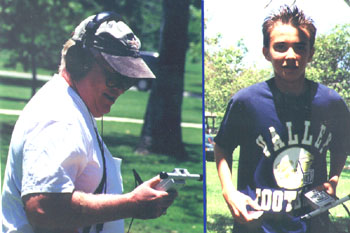
Richard Thompson WA6NOL (left) and son Jay W6JAY prepare to get 80-meter bearings.
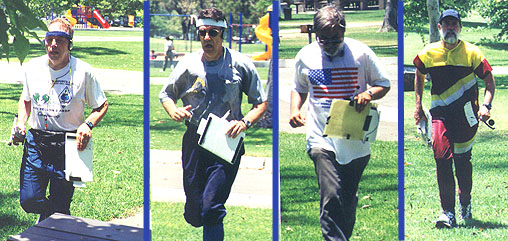
Crossing the 80-meter finish line, left to right are Dick Arnett WB4SUV, Bob Frey WA6EZV, Marvin Johnston KE6HTS and Bob Cooley KF6VSE.
Above photos Copyright © 2000 Joseph D. Moell. All rights reserved.
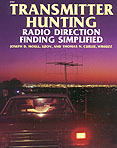 Surfing suggestion: Are you connected with Scouting? Planning for Jamboree-On-The-Air? Foxhunting might be an ideal outdoor activity. Find out more at the Foxhunting for Scouts page at this site.
Surfing suggestion: Are you connected with Scouting? Planning for Jamboree-On-The-Air? Foxhunting might be an ideal outdoor activity. Find out more at the Foxhunting for Scouts page at this site.
 Back to the Championship Foxhunting News page
Back to the Championship Foxhunting News page
Back to the Homing In home page
This page updated 5 May 2009
 The weekend's hunts were official qualifying events for the USA's ARDF Team, which competed at the 2000 World Championships in Nanjing, China during the second week of October. Six team members were in attendance, two from the local area and the remainder traveling from Cincinnati, Santa Barbara, and the San Francisco Bay.
The weekend's hunts were official qualifying events for the USA's ARDF Team, which competed at the 2000 World Championships in Nanjing, China during the second week of October. Six team members were in attendance, two from the local area and the remainder traveling from Cincinnati, Santa Barbara, and the San Francisco Bay.








